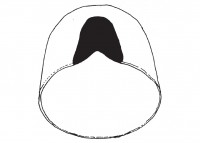Three Readings (Deodand)
DEODAND
This bell rang the signal of insurrection in Uglich, Russia, on 15 May 1591, the day that exiled ten-year-old Prince Dimitri, second son of Ivan The Terrible, was found dead with his throat cut open. Tried for treason and found guilty, the bell was sentenced to perpetual banishment in Siberia where it was sent with other convicts. The ruling also included that the culprit be silenced by having its tongue removed, which was also exiled.
After 299 years in solitary confinement in Tobolsk the bell was partially purged of its iniquity by conjuration and re-consecrated and suspended in the tower of a church in the Siberian capital. However, it still took a few years for it to be fully pardoned and returned to its original home in Uglich, where it was hung in St Demetrius of the Spilled Blood, the church erected on the exact place where Prince Dimitri had been found and the crime of his murder committed.
NO THUNDERBOLT
Judicial proceedings of this kind are called ‘prosecutions of lifeless things’ and conducted before the Athenian law-court known as the Prytaneion; they are alluded to by Aeschines, Pausanias, Demosthenes, and other writers, and briefly described in the Onomasticon of Julius Pollux and the Lexicon Decern Oratorum Graecorum of Valerius Harpokration. The law on this point as formulated and expounded by Plato (De Leg., IX. 12) reads as follows:
“If a lifeless thing shall deprive a person of life, provided it may not be a thunderbolt or other missile hurled by a god, but an object which the said person may have run against or by which he may have been struck and slain, then the kinsman immediate to the deceased shall appoint the nearest neighbour as judge in order to purify himself as well as his next of kin from blood-guiltiness, but the culprit shall be put beyond the boundaries, in the same manner as if it were an animal.”
Serve coffee individually.
The drinker of the coffee cannot read his or her own cup. The coffee should be drunk until it becomes impossible to drink any more, leaving a residue at the bottom containing the coffee grounds. The drinker should place the saucer upside down on top of the cup, flip both over, and leave to settle on the table in front of them, allowing it to drain and dry thoroughly.
Flip the cup around. Let your reader begin.
The coffee grains deposit a residue on the interior surface of the cup, depending on their coarseness, temperature, movements, porosity of materials, wetness of the mouth, vibrations, context as well as everything and everyone else present at the moment of drinking and reading. The image in the cup is, therefore, a composition and an expression of that very moment, readable from many directions starting from any subject or agent involved. Any image or sign the eyes recognise in the stains or in the gaps is taken into consideration and read according to its placement in the cup. Any image identified is considered as a symbol, bearing multiple associations at once. Any image you might see is valid. The person or the people for whom the reading is done only functions as an excuse or ground for the image to come into being.
This coffee was drunk by the conveners of an educational programme in Leipzig on the 8th of November, 2013. In order to read the image, I have divided the bowl into 3 sections: the bottom half of the bowl shows the past, the middle shows the present, the rim shows the future and the flat base of the cup shows the unconscious.
This coffee was drunk in Amsterdam on the 30th of May, 2015, by a person who wished to remain anonymous. This time another reader has divided the bowl differently, the sipping point is the present, on our left is the past and on its right is the future. On the bottom is the subconscious and towards the rim is the conscious.
This coffee was drunk by myself in New York on the 9th of November, 2015. This time, yet another reader divides the cup in yet another way. The present is around its rim, the near future is in the middle part and in the bottom of the bowl is the future.





















